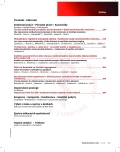Low-dose computed tomography of the skeleton in multiple myeloma staging
Authors:
L. Lambert 1; J. Straub 2; Z. Mecková 3; P. Ouředníček 4; L. Šimáková 1; D. Pohlreich 2; G. Gavelli 5; I. Špička 2
Authors‘ workplace:
Radiodiagnostická klinika VFN a 1. LF UK v Praze
1; I. interní klinika – klinika hematologie VFN a 1. LF UK v Praze
2; Ústav nukleární medicíny VFN a 1. LF UK v Praze
3; Radiologická klinika, Fakultní nemocnice u sv. Anny v Brně
4; Radiology Unit, IRCCS – Istituto Scientifico Romagnolo per lo Studio e la Cura dei Tumori (IRST), Meldola (FC), Itálie
5
Published in:
Transfuze Hematol. dnes,22, 2016, No. 4, p. 238-242.
Category:
Comprehensive Reports, Original Papers, Case Reports
Overview
The objective of imaging in plasma cell dyscrasia staging is the detection of osteolytic bone lesions and associated soft tissue masses. In 2012, we initiated a project comparing skeletal surveys using conventional radiography and low-dose CT of equal radiation dose. The end-points included clinical benefit (detection of osteolytic lesions, vertebral compressions), patient comfort, radiation exposure and cost. Seventy-four patients underwent both examinations on the same day. CT showed the presence of osteolytic lesions in 14% of patients with negative finding on radiography and excluded lesions found by radiography in 14% of patients. Conventional radiography detected only 72% of vertebral compressions depicted on CT (p < 0.05). CT moreover demonstrated the additional 31 potentially important extra-skeletal findings. The radiation exposure was 2.7 mSv for CT and 2.5 mSv for radiography (n.s.). The in-room time for radiography was 41 ± 7 min compared to 6 ± 2 min for CT (p < 0.0001). The results of this study demonstrated the difference in diagnostic power between low-dose CT skeletal survey and radiography based skeletal survey for the detection of osteolytic skeletal involvement and extra-skeletal lesions in patients with plasma cell dyscrasias. Low-dose CT can be performed with similar radiation exposure, in the same extent, at lower cost, with significantly superior patient comfort and with improved certainty of the diagnosis. This study confirms the recommendation to include low-dose CT skeletal survey as the new „gold-standard“ in the diagnostic workup of multiple myeloma.
Key words:
multiple myeloma – computed tomography – radiography – staging
Sources
1. Rajkumar SV, Dimopoulos MA, Palumbo A, et al. International Myeloma Working Group updated criteria for the diagnosis of multiple myeloma. Lancet Oncol 2014; 15(12): e538–e548.
2. Czech Myeloma Group. Souhrn doporučení 2009 „Diagnostika a léčba mnohočetného myelomu” Doporučení vypracované Českou mye-lomovou skupinou, Myelomovou sekcí České hematologické společnosti a Slovenskou myelomovou společností pro diagnostiku a léčbu mnohočetného myelomu. Transfuze Hematol dnes 2009; 15(Suppl. 2): 5–16.
3. Zamagni E, Nanni C, Patriarca F, et al. A prospective comparison of 18F-fluorodeoxyglucose positron emission tomography-computed tomography, magnetic resonance imaging and whole-body planar radiographs in the assessment of bone disease in newly diagnosed multiple myeloma. Haematologica 2007; 92(1): 50–55.
4. Minařík J, Hrbek J, Mysliveček M, et al. Racionální algoritmus zobrazovacích vyšetření u mnohočetného myelomu v podmínkách České republiky. Transfuze Hematol dnes 2015; 21(4): 200–205.
5. Lütje S, de Rooy JWJ, Croockewit S, Koedam E, Oyen WJG, Raymakers RA. Role of radiography, MRI and FDG-PET/CT in diagnosing, staging and therapeutical evaluation of patients with multiple myeloma. Ann Hematol 2009; 88(12): 1161–1168.
6. Durie BGM. The role of anatomic and functional staging in myeloma: Description of Durie/Salmon plus staging system. Eur J Cancer 2006; 42(11): 1539–1543.
7. Durie BG, Salmon SE. A clinical staging system for multiple myeloma. Correlation of measured myeloma cell mass with presenting clinical features, response to treatment, and survival. Cancer 1975; 36(3): 842–854.
8. Adam Z, Straub J, Ščudla V. Doporučení České myelomové skupiny (CMG) pro zajištění časné diagnostiky mnohočetného myelomu v podmínkách ambulantní klinické praxe. Transfuze Hematol dnes 2008; 14 : 93–94.
9. Durie BGM, Kyle RA, Belch A, et al. Myeloma management guidelines: a consensus report from the Scientific Advisors of the International Myeloma Foundation. Hematol J 2003; 4(6): 379–398.
10. Fechtner K, Hillengass J, Delorme S, et al. Staging monoclonal plasma cell disease: comparison of the Durie-Salmon and the Durie-Salmon PLUS staging systems. Radiology 2010; 257(1): 195–204.
11. Sachpekidis C, Hillengass J, Goldschmidt H, et al. Comparison of 18F-FDG PET/CT and PET/MRI in patients with multiple myeloma. Am J Nucl Med Mol Imaging 2015; 5(5): 469–478.
12. Delorme S, Baur-Melnyk A. Imaging in multiple myeloma. Eur J Radiol 2009; 70(3): 401–408.
13. Dimopoulos M, Terpos E, Comenzo RL, et al. International myeloma working group consensus statement and guidelines regarding the current role of imaging techniques in the diagnosis and monitoring of multiple Myeloma. Leukemia 2009; 23(9): 1545–1556.
14. Rajkumar SV. Myeloma today: Disease definitions and treatment advances. Am J Hematol 2016; 91(1) :90–100.
15. Baur-Melnyk A, Buhmann S, Becker C, et al. Whole-body MRI versus whole-body MDCT for staging of multiple myeloma. Am J Roentgenol 2008; 190(4) :1097–1104.
16. Mehta D, Thompson R, Morton T, Dhanantwari A, Shefer E. Iterative model reconstruction: simultaneously lowered computed tomography radiation dose and improved image quality. Med Phys Int J 2013; 2(1): 147–155.
17. Kröpil P, Fenk R, Fritz LB, et al. Comparison of whole-body 64-slice multidetector computed tomography and conventional radiography in staging of multiple myeloma. Eur Radiol 2007; 18(1): 51–58.
18. Gabzdilová J, Tóthová E, Guman T, Raffač S, Jarčuška P. Mykotické komplikácie po autológnej transplantácii krvotvorných buniek u pacientov s mnohopočetným myelómom. Transfuze Hematol dnes 2015; 21(1): 21–29.
19. Mahnken AH, Wildberger JE, Gehbauer G, et al. Multidetector CT of the Spine in Multiple Myeloma: Comparison with MR Imaging and Radiography. Am J Roentgenol 2002; 178(6): 1429–1436.
Labels
Haematology Internal medicine Clinical oncologyArticle was published in
Transfusion and Haematology Today

2016 Issue 4
Most read in this issue
- Apheresis platelets versus pooled platelets – comparison of quality and safety
- Stability of complete blood count and microscopic differential count parameters
- Low-dose computed tomography of the skeleton in multiple myeloma staging
- Frozen platelets in clinical praxis: comparative study of native platelets
